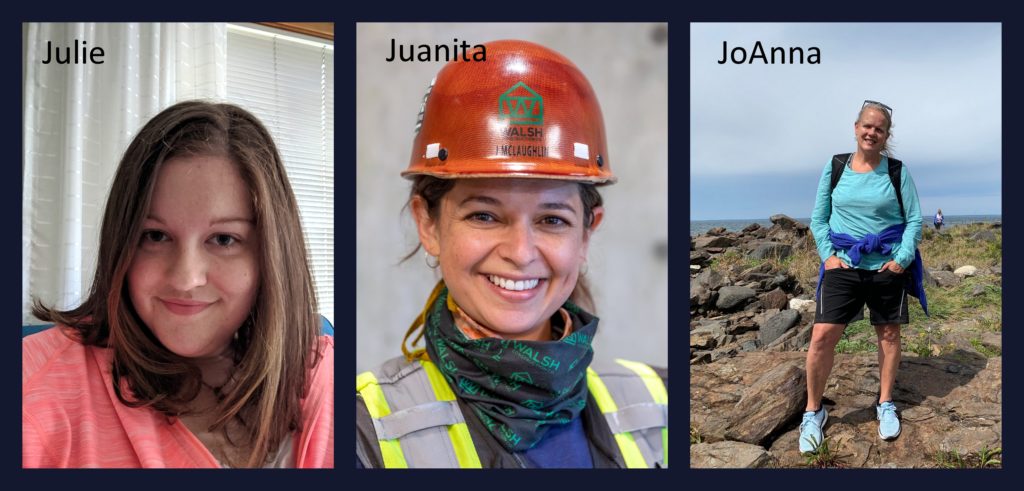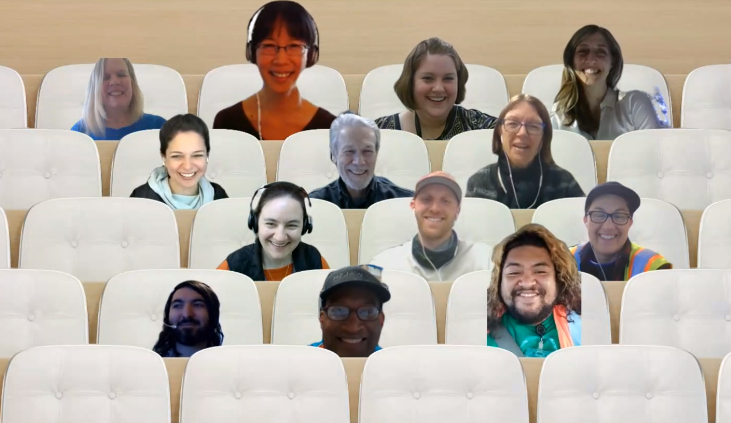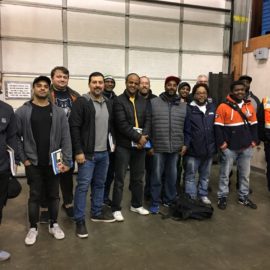
Women’s History Month offers EBP an opportunity to celebrate a few key players helping to bring the principles and practices of “exemplary building” to King County’s affordable housing sector. These women use their unique skills to bring together diverse teams and deliver the strong results that constantly move the needle towards a more equitable and sustainable future for their community. This community. Our community.
We posed the same set of intriguing questions to several of the women and women-led teams associated with EBP. We hope you’re as inspired by their stories and their leadership as we are.
The Q&A below is with three members of the team working on DESC Hobson Place South, one of EBP’s demonstration projects. DESC Hobson Place– named after the late executive director of DESC, Bill Hobson– is a two-phase project that will provide 177 new supportive apartments to people transitioning out of homelessness. The North Phase was completed in 2020 and includes 85 apartments. The South Phase, which will be complete in early 2022, includes a three-story healthcare and behavioral health clinic operated by Harborview and 92 apartments on the upper levels that are built to Exemplary Building and Passive House standards.

Julie Nordgren, Housing Developer (DESC),
Juanita McLaughlin, Project Manager (Walsh Construction), and
JoAnna Martin, Development Project Manager (Lotus Development Partners).
How long and in what ways have you been involved with HDC’s Exemplary Buildings Program? What is it about EBP that resonates with you?
[Julie] I am new to HDC’s Exemplary Buildings Program as it has only been recently that I’ve taken on a leadership role in the Hobson Place project for the owner’s team. I really appreciate that EBP not only posits that affordable housing and energy efficiency can coexist, but that energy efficiency can improve the lives and the care of DESC’s target tenant population in some very creative ways. [Juanita] I have been involved in an Exemplary Buildings Program project for nearly two years, as a project manager for Walsh Construction on the Hobson Place project. The field execution of the Exemplary Buildings Program themes and goals is what resonates with me. Seeing the impact of community advocacy in the field is both exciting and technically interesting. [JoAnna] I learned of the Exemplary Buildings Program in 2019 through my consulting work with Lotus Development Partners on DESC’s Hobson Place. The project is a two phase development with 177 studio units above an integrative health care clinic. From the project’s inception it was to be unique. Never before had permanent supportive housing been combined with physical and behavioral health care on the same site. The innovative program for Hobson was dependent on extremely complicated and, as yet, uncommitted financing. So when Sondra Nielsen, Facilities Director at DESC, asked whether we could also achieve Passive House certification, Michelle Morlan, Partner and Principal at Lotus Development Partners, and I were not initially on board. Of course it would be great to lower DESC operating costs and the impact of buildings on climate was understood. Yet, housing dollars were/are scarce. Wouldn’t this add cost? Would funder-imposed development cost limits mean the project wouldn’t get funded? Had Passive House ever been achieved in Permanent Supportive Housing? The project is mixed use. Would both uses be Passive House certified and if not, how would we make a housing “bubble” and certify that? We had several energy efficiency features incorporated to meet ESDS and DESC’s program requirements, but we were about to submit our building permit package. Surely it was too late to entertain such a dramatic change! Enter Exemplary Buildings Program taskforce members who donated time and talent to help us vet feasibility. They helped answer our technical questions and pointed us to additional funding resources from WA State Commerce’s UHEE program and Seattle City Light. I believe it is absolutely critical that we figure out how to create buildings that are less harmful to our planet and more sustainable for our clients. The Exemplary Buildings Program is making it easier to swim against what feels like an opposing current. Hopefully we can eventually change the direction of the current.Why are your specific skills and unique traits necessary and important for this work? How do they come into play in balancing the goals of delivering “exemplary” housing while maintaining affordability?
[Julie] In a lot of ways, I have been the lucky one in this process. I work with an incredibly skilled team of individuals who collectively seem to know all there is to know about design and construction. I have been in the enviable position of coordination –- I make sure that each person has what they need to get their part of the job done and spend the rest of the time soaking up as much knowledge as I can. What I bring to the team is real-world experience working with DESC’s clients in our buildings. This is very helpful when it comes to making decisions around affordability. With the team’s knowledge and my experience in housing, we can decide collectively what we can and can’t live without. [Juanita] Finding opportunities for success is at the heart of field implementation, and for Exemplary Buildings Program goals there is also an added layer of urgency. We as a community know we need to find answers to most urgent and persistent challenges, and we also know that climate change and homelessness are currently at the top of the list. Our opportunity for success on Hobson Place is to find replicable ways to address climate change and homelessness with limited resources and limited time. The Hobson Place team is always scouting for opportunities to be innovative and bold, and also efficient in terms of time, and cost-conscious in terms of resources. There is no better proving ground than the fast-paced environment of an active construction site to put the EBP goals to the test of time and efficiency. I personally bring the ability to ask tough questions as early as possible in pursuit of efficient, replicable solutions to challenges we may see in the field, so that we can allocate the right resources and have a plan in place prior to starting a task. [JoAnna] I came at this from an architecture and planning education; however, it was a sense of social responsibility that brought me to affordable housing. Work tied to such a clear mission always felt good and I’ve found the people drawn to this kind of work fun and inspiring. As a consultant, each project varies dramatically depending on the client, site and program. So much is learned on the job. As far as traits go, I think this work takes a healthy dose of optimism with just enough field experience to know how to anticipate and navigate setbacks. Our Lotus team, and perhaps more importantly, our client contact at DESC, Julie Nordgren, have both in spades. Achieving an exemplary building whilst maintaining affordability also requires attention to detail and the patience to wade through countless technical details. Maria Llobet, Lotus Construction Manager and Michele Wang & Pardis Moinzadeh of Runberg Architecture Group have been tireless collaborators on that front. Perhaps the most important trait in this line of work is humility. This is necessary to acknowledge what you don’t know so that you can reach out to those who do for help. It takes a team to do this work!One of EBP’s defining traits is its collaborative model and team-based approach. Tell us a bit about how your team worked together to achieve exemplary building goals: what were the values, individually and collectively, that were most important to success?
[Julie] One of the most important parts of working collaboratively to achieve EBP goals was good communication and creative problem-solving. Each member of the team was able to effectively communicate their concerns or suggestions in a way that made sure we always kept the end-user—be it the tenant, the onsite staff, or the facilities staff—front of mind. We designed a special building for a special type of tenant and that was always the guiding value. [Juanita] We are still in process of working together as a Hobson Place team to achieve the EBP goals, as Hobson Place is about 50% through construction. However, I would say to date the key to our success has been early collaboration, because that has given the Hobson Place team the maximum amount of time needed to resolve issues or questions before the task is due to be implemented in the field. Collective commitment to resolving problems has resulted in our ability to perform work on an accelerated schedule, so that we as a team can deliver this important and much-needed project to DESC and to the greater community earlier than the contractual completion date. The Hobson Place team has been together through the thick and thin of this past year, so I think our superpower really is our team-focused approach.
What leadership tool will you take forward from the extraordinary challenges of this past year?
[Julie] The wonderful women I’ve worked with from Runberg Architecture Group, Walsh Construction Company, and Lotus Development Partners have modeled extraordinary grace throughout my time with the project. I have been able to ask questions and make mistakes and have been met with nothing but gracious generosity. This past year has been so taxing for so many and watching the people around me continue to commit themselves to compassion has inspired me to work on the leadership tool we don’t always recognize as a leadership tool – the ability to build and preserve relationships through kindness. [Juanita] Everyone in the design, development, and building field has performed work under the strangest, most unexpected challenges in this past year, and through each moment the importance of teamwork has remained more important than ever. Teamwork, and keeping a collective commitment to rising to challenges, has been so crucial to any success in the past year. The leadership tool I will take forward is remembering that teamwork is the key! [JoAnna] This is a tough question. Being isolated and working remotely, it is hard to feel like a leader. Is virtual leadership actually leadership? I’m not sure. Are relationships built on screen real? Time will tell. I think 2020 has required patience and kindness. That our important work has been able to continue when others have lost jobs is extraordinary. I am grateful.What would you say to a younger woman who is considering entering the architecture, engineering and construction (AEC) industry? What do you wish you had known prior to entering your profession?
[Julie] First of all, I am only two years into this industry and probably shouldn’t be advising anyone about anything quite yet! However, right now, this is what I would say: Find yourself a mentor. (Preferably Sondra Nielsen, DESC’s Director of Facilities and Asset Management. She’s the best there is.) If I could go back and give myself some wise counsel when I was first starting it would be this: do not be afraid of asking questions. This industry is ever-changing and everyone in it is engaged in a process of constant learning. It is what makes it, sometimes, quite intimidating, but also incredibly rewarding. [Juanita] I would say, “Welcome, come on in! There’s room for you! You are needed, and there is work to be done, so roll up your sleeves.” I wish I had known that there are mentors and supporters all around, ready to welcome women from every stage of their careers into this field and to help us succeed. I feel like the AEC industry is a more welcoming industry than it may seem from the outside looking in. The key is finding the right fit – I would encourage any woman from any stage in her career to search for the right fit, and to keep looking until they find it. There are mentors everywhere, from all genders, ready to engage and help people learn and contribute to the great work we all do each day. I found my own path from urban planning to development and eventually to where I am in construction, and along my way I have been so fortunate because I have worked with many, many talented and dedicated people who have counseled and guided me. [JoAnna] Absolutely do it! The hard and soft skills learned in these fields are invaluable and transferrable to so many things in life. While I don’t draw or design anything anymore, I call upon the skills I learned in architecture, almost every day.On a lighter note: What or who has been an empowering song, poem, book, movie, or person for you this past year?
[Julie] I have always loved a poem by Lisel Mueller called “The Laughter of Women”. The first stanza reads:“The laughter of women sets fire
to the Halls of Injustice
and the false evidence burns
to a beautiful white lightness.”
But go read the whole thing! It is genius!
[Juanita] I have two poems on my wall near my desk: “Carrying Our Words” by Ofelia Zepeda, and “Still I Rise” by Maya Angelou. I put these poems up in March of 2020, and I look at them each day. These poems have reminded me this past year of the power of grace and perseverance, and that no matter what the challenge, inside each of us is the power to make a difference in our world each day. [JoAnna] Ruth Bader Ginsberg. Smart, strong, brave ….I could go on and on.Julie, Juanita, and JoAnna are three of the women making an extraordinary contribution to EBP… read more stories of EBP’s women leaders here.


